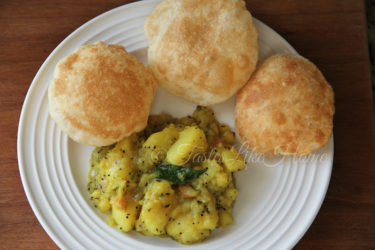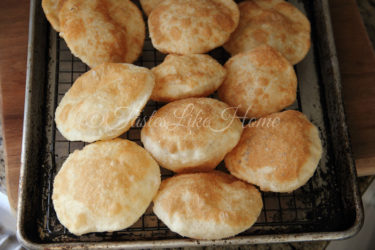Hi Everyone,
 One of the most requested recipes I get is for Poori. This Indian fried flat bread is always on the menu for special occasions such as weddings, and festivals – like this weekend’s Diwali. While the pronunciation is familiar as well as the other version of the spelling puri, it is very different from the Dhal Puri with which we are familiar.
One of the most requested recipes I get is for Poori. This Indian fried flat bread is always on the menu for special occasions such as weddings, and festivals – like this weekend’s Diwali. While the pronunciation is familiar as well as the other version of the spelling puri, it is very different from the Dhal Puri with which we are familiar.
Luchi/Poori has its roots in Bengali cuisine and is also made in the northern states of India. When it is made with whole-wheat flour it is called Poori, however, when it is made with regular all-purpose flour, it is known as Luchi. For the purpose of this column, we will refer to it as Poori even though the recipe calls for all-purpose flour. Like bakes, it is fried dough and very much resembles float bakes the bakes that puff up with a hollow pocket which can be filled with a variety of tasty goodies.

(Photo by Cynthia Nelson)
Poori(s) are usually served with Masala Potatoes (curry mashed potatoes), curried channa, and parsad (flour halwa/sheera) among other things. Poori has no flavour in and of itself so that is what makes it amenable as an accompaniment to both savoury and sweet dishes.
At the Hindu weddings of some of my cousins I would see the women folk sitting flat on the ground rolling small balls of dough into perfect flat circles. All the rolled dough would be arranged on a platter and covered with cloth towels to avoid the dough drying out. When a platter was full, it was carefully transported to another part of the yard that had been set up for outdoor cooking, to be fried in a large karahi of hot oil.
It is obvious that I always only ever ate Poori when it was served cooled and deflated (always with parsad), because if I had Poori while still soft and warm, I would have been more enamoured by it. I just did not get the point of that Poori. It was always hard, bland, and seemed like an oil-laden unusual roti. I would always discard the Poori and sit quietly eating and thoroughly enjoying my parsad. I could not figure out why they would want to hide my sweet, soft, cardamom-spiced parsad in such a thing.
Several years ago when I got the first request for Poori, I turned to my mom and aunt, Betty, as I had witnessed both of them partaking in the food prep at the weddings of relatives. The ingredients and instructions were as follows: flour, water, salt and little ghee to make the dough. Knead it, let rest then cut the dough into little balls, roll, and fry them. Seems simple enough, but I was not satisfied so I decided to do some digging around myself. Thanks to food blogging we can all learn of the little things that are not always included in a recipe as a lot of cooking is by instinct and learning by watching and doing. Here’s what I learnt.
- The dough when kneaded should be stiff but pliable; it should not be as soft as the dough for paratha roti.
- It is important to knead the dough well to develop the gluten, about 5 – 6 minutes.
- The dough should rest for at least 15 minutes, however, from the various times I have made Poori, I have come to realize that letting the dough rest for at least 30 minutes and even longer helps it to puff up more easily.
- Adding a tablespoon or 2 of semolina flour to the all-purpose flour mixture helps the Poori to stay puffed even after it is cool.
- Like float bakes, the temperature of the oil is important for the Poori to sink and then rise to the top and swell.
- Poori(s) are traditionally fried in ghee making it richer and giving added flavour, however, vegetable and canola oil are excellent substitutes.
- When the Poori is swollen and stops bubbling on one side, it is ready to flip to cook the other side. Poori takes only about 1 minute to cook completely.
- If not serving right away, store the Poori while it is still warm in an insulated container; if you let them cool completely before storing then they will become chewy.
Ready to make some Poori?

INGREDIENTS
- 2 cups all purpose flour
- 2 tablespoons semolina flour (optional)
- Salt to taste
- 2 tablespoons ghee
- Room temperature water
- Oil for deep-frying
DIRECTIONS
Mix together the flour, semolina (if using) salt and ghee.
Add the water a little at a time to form a stiff dough. When the dough comes together, knead for 5 – 6 minutes or until smooth. Rub a little oil over the dough, cover, and let rest for at least 30 minutes.
Add oil to deep frying pan and place over medium heat. Meanwhile, cut the dough into small pieces (about 20 – 24) and roll into balls. Cover to prevent the dough from drying out.
Roll about 6 to 8 pieces of dough into a thin, even layer, and place on a platter or large plate and cover with a kitchen towel.
When the oil is hot – shimmering on the surface, fry Poori one at a time or 2 – 3 at a time depending on the breath and size of your karahi. Drain on wire racks lined with paper towels. Repeat until all the dough is rolled and fried.
Serve warm.
Shubh Diwali!
Cynthia





